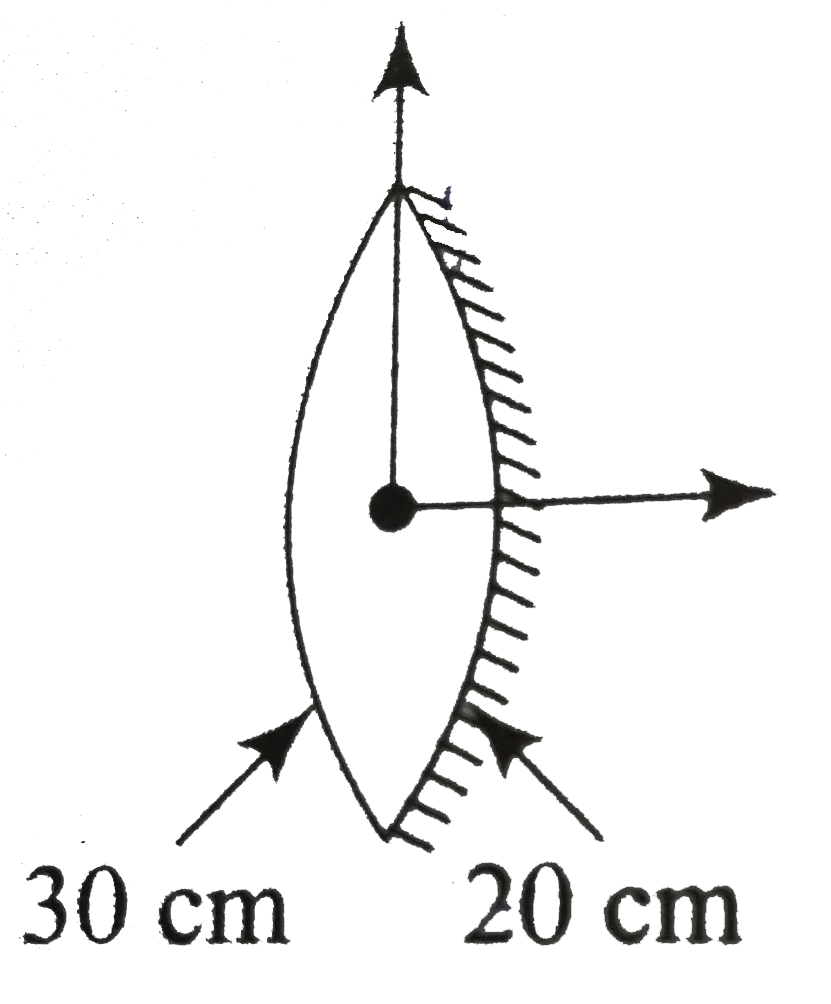The concave and convex surface of a thin concavo-convex lens of refractive index 1.5 has radius of curvature 50 cm and 10 cm respectively. The concave side is slivered then if the equivalent focal length of the silvered lends is −5xcm then find x.
The correct Answer is:5
To solve the problem, we need to find the equivalent focal length of a silvered concavo-convex lens with given parameters. Let's break down the solution step by step.
Step 1: Identify the parameters
- Refractive index (μ) = 1.5
- Radius of curvature of the convex surface (R1) = +10 cm (positive because it is convex)
- Radius of curvature of the concave surface (R2) = -50 cm (negative because it is concave)
Step 2: Calculate the focal length of the lens
Using the lens maker's formula:
1f=(μ−1)(1R1−1R2)
Substituting the values:
1f=(1.5−1)(110−1−50)
=0.5(110+150)
Step 3: Simplify the expression
Finding a common denominator for the fractions:
110=550
Thus,
110+150=550+150=650=325
Now substituting back:
1f=0.5⋅325=350
Step 4: Calculate the focal length (f)
Taking the reciprocal:
f=503 cm≈16.67 cm
Step 5: Consider the silvered concave surface
When the concave surface is silvered, it behaves as a mirror with a focal length given by:
fm=−R2=−−502=−25 cm
Step 6: Combine the lens and mirror
The equivalent focal length (F) of the system (lens + mirror) can be calculated using:
1F=1f+1fm
Substituting the values:
1F=350+1−25
Finding a common denominator:
1−25=−250
Thus,
1F=350−250=150
Step 7: Calculate the equivalent focal length (F)
Taking the reciprocal:
F=50 cm
Step 8: Relate to the given focal length
According to the problem, the equivalent focal length of the silvered lens is given as:
F=−5x
Setting the two expressions equal:
50=−5x
Solving for x:
x=−505=−10
Final Answer
The value of x is −10.
---
- Refractive index (μ) = 1.5
- Radius of curvature of the convex surface (R1) = +10 cm (positive because it is convex)
- Radius of curvature of the concave surface (R2) = -50 cm (negative because it is concave)
Using the lens maker's formula:
1f=(μ−1)(1R1−1R2)
1f=(1.5−1)(110−1−50)
=0.5(110+150)
Finding a common denominator for the fractions:
110=550
Thus,
110+150=550+150=650=325
1f=0.5⋅325=350
Taking the reciprocal:
f=503 cm≈16.67 cm
When the concave surface is silvered, it behaves as a mirror with a focal length given by:
fm=−R2=−−502=−25 cm
The equivalent focal length (F) of the system (lens + mirror) can be calculated using:
1F=1f+1fm
Substituting the values:
1F=350+1−25
Finding a common denominator:
1−25=−250
Thus,
1F=350−250=150
Taking the reciprocal:
F=50 cm
According to the problem, the equivalent focal length of the silvered lens is given as:
F=−5x
Setting the two expressions equal:
50=−5x
Solving for x:
x=−505=−10
The value of x is −10.
Similar Questions
A plano-convex lens has refractive index 1.6 and radius of curvature 60 cm. What is the focal length of the lens?
View SolutionA biconvex lens is made of glass with refractive index 1.5 and has radii of curvature 20 cm and 30 cm. If the 20 cm surface is silvered, what is the effective focal length of the mirror formed?

View Solution
Knowledge Check
The radius curvature of each surface of a convex lens of refractive index 1.5 is 40 cm. Calculate its power.
A2.5DB2DC1.5DD1D
The convex side of a thin concavo-convex lens of glass of refractive index 1.5 has a radius of curvature of 20cm. The concave surface has a radius of curvature of 60cm. What is the focal length of the lens? The convex side is silvered and placed on a horizontal surface. What is the effective focal length of the silvered lens? The concave part is filled with water with refractive index 1.33. What is the effective focal length of the combined glass and water lens? If the convex side is silvered what is the new effective focal length of the silvered compound lens?
View SolutionThe convex surface of a thin concave-convex lens of glass of refractive index 1.5 has a radius of curvature 20 cm. The concave surface has a radius of curvature 60 cm. The convex side is silvered and placed on a horizontal surface as shown in figure. (a) Where should a pin be placed on the axis so that its image is formed at the same place ? (b) If the concave part is filled with water (mu = 4/3), find the distance through which the pin should be moved so that the image of the pin again coincides with the pin.

View SolutionA concavo-convex lens has refractive index 1.5 and the radii of curvature of its surfaces are 10cmand20cm. The concave surface is upwords and is filled with oil of refractive index 1.6. The focal length of the combination will be
View SolutionA plano convex lens is made of glass of refractive index 1.5. The radius of curvature of its convex surface is R. Its focal length is
View SolutionFor a plane convex lens (μ=1.5) has radius of curvature 10 cm. It is slivered on its plane surface. Find focal length after silvering:
View SolutionThe plane surface of a plano-convex lens of refracting index 1.5, is silvered. The radius of curvature of curved surface is R. Find the focal length of the mirror thus formed.
View SolutionA plano-concave lens is made of glass of refractive index 1.5 and the radius of curvature of its curved face is 100 cm. What is the power of the lens?
View Solution
